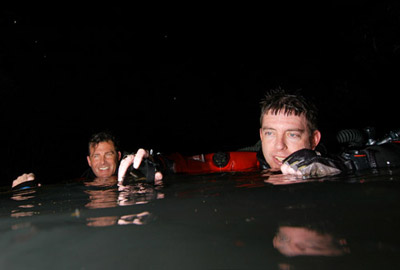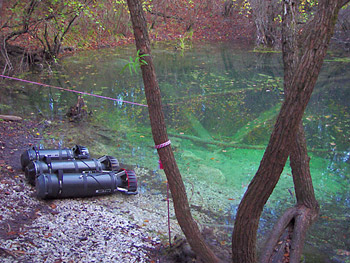 |
|
Chip's Hole, aka
"Pipeline"
|
More photos in the
Chip's Hole Project photo gallery
Overview
Over the past few months the WKPP has been preparing for an
exploration push in the Chip’s Hole Cave System, aka
"Pipeline." Conditions within the Pipeline System are different
from those in other parts of the WKP due to the water source and
the fact that this system is less sensitive to surface water
intrusion than the Leon Sinks and Wakulla Cave System. The cave is
also unique in that for most of the initial 2,500ft the cave is
extremely small and restrictive requiring extensive setup and
cleanup. I felt we had the team in place to get this project off
the ground and made arrangements at the beginning of the year to
kick things off.
The project consisted of 3 phases: site
prep, setup and exploration. Site prep took the better part of 6
months as we had to deal with some early season tropical systems
and rain. We also had to reline the first 2,500ft of cave and
remove 20+ years of twist, braided, electrical cord and phone cord
used by divers to negotiate the system over the years. The cave
profile is unique in that the depth isn't as much of an issue as
the cave configuration-- small/silty/shallow, small/sandy/midrange,
medium/silty/shallow, large/silty/midrange, medium/silty/shallow,
large/silty/midrange and massive/silty/shallow.
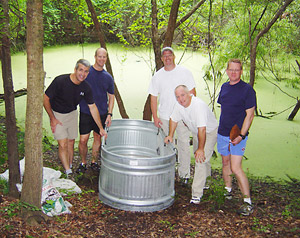 |
|
Jim Miller, Hunter &
Brian Swearingen, Scott Cox, and Walter Gordon on an
early set-up dive to place the
upstream habitat
|
Phase 1 and part of Phase 2 were done
on open circuit to assess the line and determine if it would be
usable. Long range Phase 2 setup and Phase 3 exploration was done
on Halcyon RB80's. Bottom gas was 21/50 with plans to evaluate gas
needs should the cave drop deep into the Leon Sinks System. I am
preparing a more detailed write-up but wanted to bring the rest of
the team into the loop. Despite it being more than 5 years since
the WKPP extended the line in Wakulla to 19,000+, exploration is
alive and well in the WKP and within the WKPP. Quite honestly,
it’s what we do better than anyone and this project was no
exception. Our support and cleanup teams took care of business, got
the job done and I credit their efforts in giving the exploration
team the best shot we could ask for.
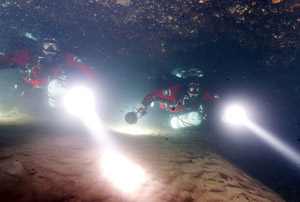 |
|
Jarrod Jablonski and Casey
McKinlay on a set-up dive during phase 2 of the project. Photo by
David Rhea
|
Support Summary, 21-22 October
2005
Todd Leonard
Friday, 21 October:
Bennett, Cox, Leonard, and McKinlay met in High Springs to caravan
to Chip's for the final setup dives. All worked to transport gear
to the water, then Bennett and Leonard began their dive. It was a
double-stage single scooter dive, with each diver transporting a
payload of two Magnum scooters, one drive bottle, and one 70ft deco
bottle. The 70ft bottle was placed in a 60ft deep room just
upstream from the Cal's restriction, the best available deco
location before the final ascent/exit through small, shallow, and
extremely silty conduit. The drive bottle and setup team's first
stage bottle were dropped adjacent to the first safety depot.
Finally, the Magnums were dropped
adjacent to the second safety depot. On the way out, the gold line
was repositioned and snugged in a few positions. Back in the basin,
Cox joined the others to ferry gear to the surface and setup the
trough with deco gas.
Saturday, 22 October:
With setup completed and the silt allowed to settle overnight, the
push team and initial support crew met for breakfast at 6:30am,
then proceeded to Chip's to get the day started. Cox and Gordon
assembled their gear immediately to remain on standby throughout
the day as safety divers, while the rest of the crew aided the push
team in assembling gear and moving it to the water's edge.
Additional support crew arrived in time to see the push team get
underway at 11:04am, which began the long process of waiting and
regularly monitoring the basin for bubbles. The expected bottom
time ranged from 400-600min (not counting time in the cave
decompressing on the 70ft bottle), but the support team had to be
ready to initiate safety and cleanup dives at any time.
The support crew enjoyed each other's
company throughout the day, watching movies ("Sin City" and "The
Godfather") and football, checking the news for details on
Hurricane Wilma's progression, and feasting on BBQ. Italian divers
Fabio as well as GUE instructors Gideon and Mario were on hand
after a week of training with JJ; they were treated to a local
surface tour of several WKP sites. Cox and Gordon setup the trough
with deco harnesses, food tubes, and drink bags. The other support
divers assembled gear and placed scooters and stages at the water's
edge for the first cleanup team. As the night wore on the Italian
contingent made a run to Crawfordville for pizza. Finally, around
9:30pm, the bubbles returned. The crew's long wait was over, and it
was time to get back to work.
Koritz and Leonard got in the water for an initial check on the
push team, and to get a summary of what gear remained in the cave
and where. They returned to the surface with news, then began the
first cleanup dive with one scooter and three stages each.
Meanwhile, Cox and Gordon got in the water to monitor the push team
as they decompressed, assist them out of the breathers, and ferry
used gear to the surface.
The gear waiting in the cave included six Magnums and 10 bottles at
the second depot, plus two more Magnums and some more bottles at
the first depot. Given the cave's tight and silty conditions,
multiple trips would be necessary. Koritz and Leonard dropped their
first stage and one fresh stage at the first depot, then continued
out to the second depot. They each picked up two scooters and three
bottles, and returned to drop them at the first depot. After
exchanging their spent stage for a fresh one, they made another run
from the first to the second depot for the remaining gear. On
return to the first depot they switched back to their first stage,
picked up a little more gear, then returned to the basin. Bottom
time was around 130min.
While Koritz and Leonard began their deco, Jablonski and McKinlay
were coming out of the trough for their final ascent. Meanwhile,
Cox and Gordon continued to monitor the push team and ferry gear to
the surface, while Bennett and Messersmith began the second cleanup
dive. The effort included four two-man teams operating seamlessly,
well past midnight in a cramped basin with lousy viz -- welcome to
the WKPP.
Bennett and Messersmith traveled downstream on a single stage,
picking up all gear remaining from the first depot. They scootered
back to the basin with three magnums, six stages each and a bottom
time of around 50min. While they did a little deco, Cox and Gordon
pulled the last of the gear to the surface. The divers exited the
water around 2:00am.
The full support crew continued to work at the surface, raising
gear from the water's edge to the parking area, disassembling and
packing it, and putting away the canopies and camping gear.
The support crew for Oct 20-21 consisted of:
Curtis Baldwin
Derek Bennett
Scott Cox
Shellie Foss
Walter Gordon
Terry Koritz
Todd Leonard
Mark Messersmith
Doug Mudry
Hunter Swearingen
Renee and Hannah
Gideon Liew, Mario Arena, Fabio
Earlier support teams included Anthony Rue, David Rhea, Jim
Miller, Brian Swearingen, Alison Adler, Carol Deegan, Mark Garland,
Todd Kincaid, Doug Mudry, and Charlie Roberson.
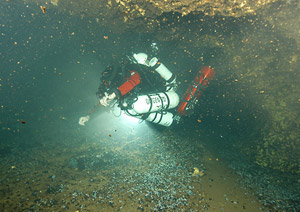 |
|
Jarrod Jablonski on the way
out of Chip's Hole after the October 22 exploration push. Photo by
David Rhea
|
Exploration
Summary
Jarrod Jablonski and Casey McKinlay
For the exploration push at Chip's Hole, Jarrod Jablonski and Casey
McKinlay submerged at 11:04am on Saturday, October 22, 2005 and
surfaced 14 hours later at 1:00am on Sunday, October 23. Total
distance traveled from Chip's Hole was 34,500ft roundtrip. The team
arrived at the end of the line at 14,200ft from Cal's Cave
(previous exploration by WKPP divers Rick Sankey and Brent Scarabin
in 1996) in less than 160 minutes. The team tied in and added
2,220ft of line in addition to survey and video for a total
distance from Cal's of approximately 16,500ft. The team spent 132
minutes in the newly explored section of cave; this effort involved
exporing three side leads as well as scouring the cave for
additional possibilities. Finally the team decided to began the
long journey back to the surface. Exit time would be 210 minutes
for a total bottom time of 502 minutes. Decompression would add 338
minutes to the profile for a total of 14 hours at an average depth
of 100ft, max depth 150ft and minimum depth of 43ft. Exit time was
25% longer due to the siphoning flow of water in Chip's as well as
the large amount of equipment (5 scooters and 6 drives) in
tow.
Jablonski and McKinlay used Halcyon RB80 Rebreathers, 2 standard
Gavin jump scooters, 7 Magnum Gavins and 1 specially modified 45amp
NiMh Gavin with video and 50wt HID lighting attachment – aka
"Mini-Mee." Safety depots were established at 1,000ft, 2,500ft,
3,500ft, 7,000ft and 12,000ft during previous setup dives. Drive
bottles were switched at 3,500ft, 7,000ft, 12,000ft in addition to
an extra drive bottle on each diver during exploration/survey and
two extra drive bottles left at 14,200ft for future exploration.
Scooters were also switched at each drive switch with the jump
scooters used for the first 3,500ft of cave past Cal's and the
third scooter driven to 14,200ft so the exploration team could
tie-in with a fresh scooter and spare scooter in tow. The team used
custom designed Halcyon 13.5 hour NiMh primary lights and two
special exploration reels designed by Halcyon production manager
Steve Pulliam; each reel is capable of holding 3,500ft of #18
braided line.
After moving carefully through a few long sections of restrictive
cave that are further complicated by huge mounds of silt, the team
motored past Sheck's Rock at 10,444. From our perspective, this
dive was Sheck's most significant; it is impossible not to be
impressed by this monumental 1989 swim dive which left him swimming
roughly two miles out of a notable siphon. It is also interesting
to note that the line from 2,000ft to 10,444 is exceptionally well
placed and in excellent condition for 15+ year old twist. At 10,444
the team picked up Sankey and Scarabin's line running to 14,200ft.
The line was also well placed through some medium to large
passageway with bizarre rock features and the deepest point in the
cave at 150ft. The last few hundred feet the cave began to open up
slightly and shallow-up significantly. The team reached the end of
the 1996 line and the depth was 43ft. The switch was made to fresh
scooters with extra tanks left for later exploration. Jarrod tied
into the end of the old line while Casey fired up the camera and
video lighting. The cave became wide at that point with floor to
ceiling height around 10ft. Jarrod motored ahead and the cave began
to open up and the ceiling disappeared. Jarrod hugged the left wall
as Casey followed 20-30ft behind with the camera. The visibility
was 30-40ft with a milky haze making it difficult to determine
exactly where the cave was headed. The right wall and ceiling were
occasionally not visible due to the haze. Slowly, the passage began
to develop into monster size sized cave with very little breakdown
on the floor; there were ample quantities of silt. The
once-noticeable strong siphon flow became less apparent.
At first this drop seemed in response
to the size of the conduit, but it slowly became obvious that the
flow was becoming more diffuse. We hit a huge room, wrapped, and
headed down into a beautiful, yet smaller tunnel on the left that
dropped down to the 100ft level. The tunnel zigzagged for several
hundred feet before ending. Jarrod tied off, we grabbed the survey
data and returned to the big room where Jarrod dropped an arrow on
the line, tied in and headed across the room in search of the main
tunnel, which he quickly picked up. We motored on, with the cave
remaining relatively shallow (in the 50-70ft range) and staying
huge. We continued down the main passageway and the tunnel
eventually shut down; we tied off, backed up and began reviewing
the options. The ceiling height was approximately 30-40ft; in
several areas we discovered a thick tannic layer above this depth.
It appeared that we were below a swamp or lowland feature on the
surface. Jarrod found a small lead which we pushed past two single
file restrictions but they contained tannic water and no flow. We
checked a few other options and ultimately decided to began exiting
while conducting the survey and searching for additional leads.
Casey switched to the backup scooter and shutdown the video to
begin the survey. The survey was quick, due to the massive
dimensions of the tunnel. In fact, one of these shots ran in the
same direction for 440ft. Jarrod rode the left wall out and could
not find any going passage way. Given that we had explored along
the left wall on the way into the cave it seemed unlikely that we
missed anything there. Where did the flow go? Had a lead been
missed on the lower level before the end of the line? Did the flow
just branch out and disappear like downstream Sally Ward? We
decided to wrap it up and move the extra tanks back to 12,000ft for
a final look on the eventual cleanup dive. Jarrod checked for leads
on the exit and marked one; this would have to wait for another
day. It would require at least three hours to get out of the cave
and it was time to go home.
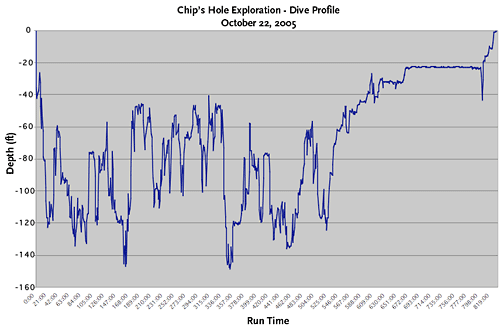
The WKPP is preparing a complete
report, as well as images and video to be released on the GUE site
in the very near future. While the WKPP has been very active in
terms of scientific research, several years of high water in
Tallahassee have hampered our regular efforts at exploration. We
remain hopeful that we are off to a good start and are preparing
for an active winter. It will be a pleasure to enjoy old friends,
new cave, and extensive exploration.
|
|
|
Jarrod Jablonski and Casey
McKinlay surface after 14 hours in the Pipeline system. Photo by
David Rhea
|
|
Project made possible through the support of:



|








